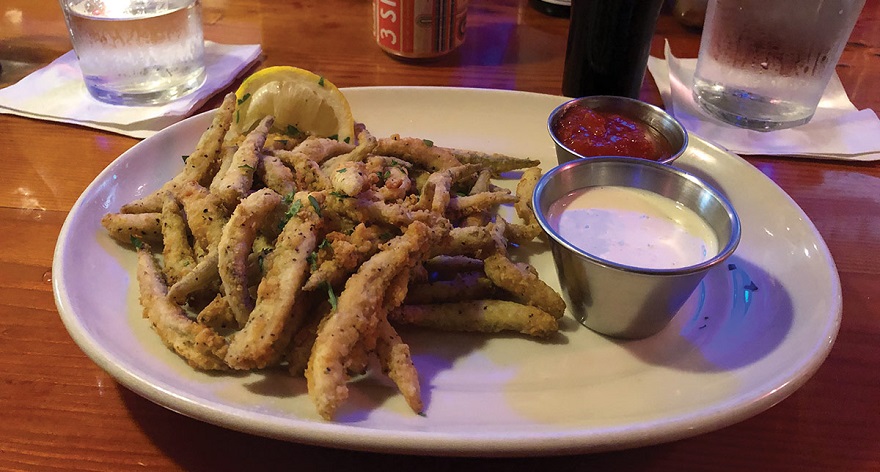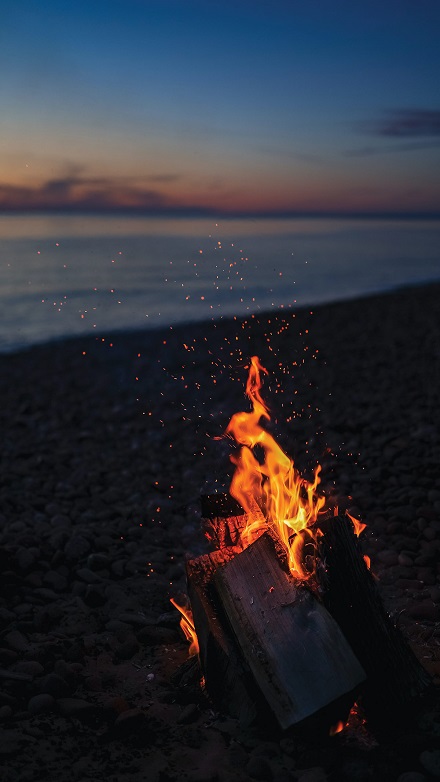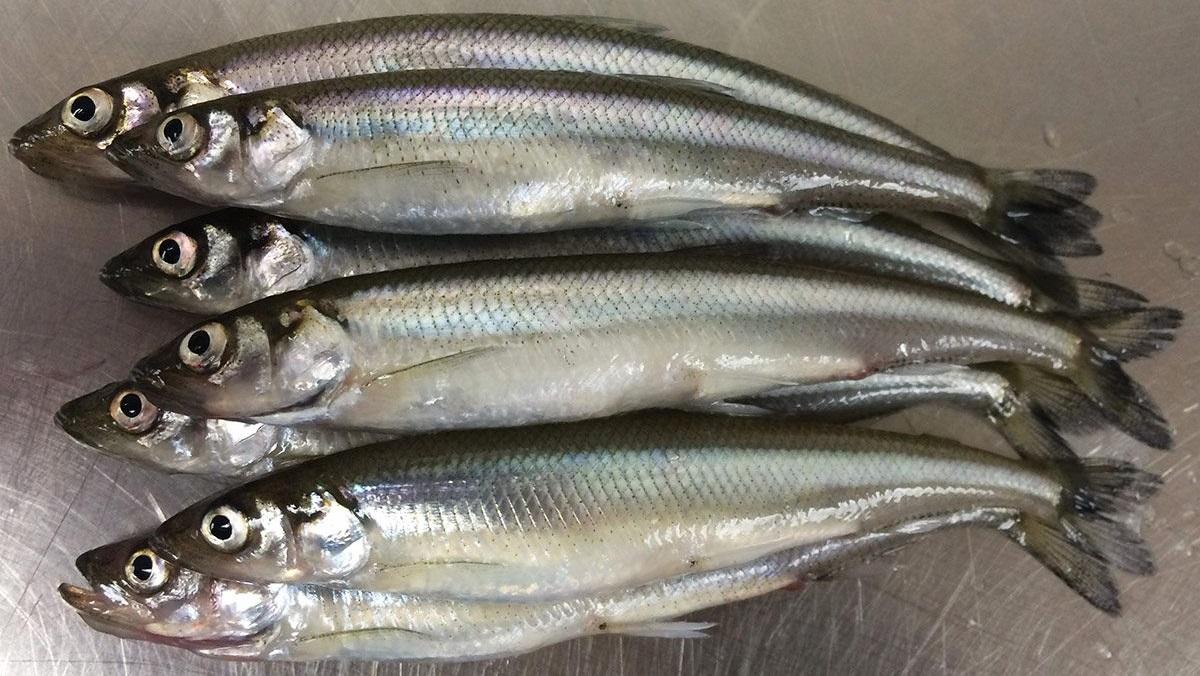Anthony Bourdain, celebrity chef and provocateur, once said that good food and good eating involve an element of risk. I believe he was talking about oysters. One of my risky food experiences involved a different kind of seafood. As I recall, it was March or April in the early 1980s when a friend from Crivitz, a small village north of Green Bay, invited me to go smelting. It was an annual tradition, he told me, and he’d just got word that the smelt were running. I didn’t know what a smelt was, why it would be running, or where to. It didn’t sound like great eating, but he said there would be beer. So I found myself one night stumbling into Lake Michigan somewhere north of Milwaukee in the dark in borrowed hip boots with a dip net.
Small fried fish appear in cuisines all over the world. In the U.K., they’re called whitebait, young sprats, which are a type of herring. The U.K.’s Fish Society explains, “the whitebait concept—very small fish cooked and eaten whole including head, fins, bones and innards–is recognized all over the world…[and] is applied to different species reflecting what is or was available locally.” In Finland, muikku is pan-fried or smoked; in Japan, shishamo, a native smelt, is grilled or fried whole and served with its roe; in Turkey, papalina are served with lemon juice and olive oil; in Mexico, charales are deep-fried and served with salt, chili peppers, and a squeeze of lime juice. Beer seems to be the beverage of choice world-wide to wash down small local fried fish, and in Wisconsin, not surprisingly, that is also the case.
For many years, springtime in Wisconsin has been smelt season. Along river mouths and shorelines of Lakes Michigan and Superior the water shimmers with smelt swimming upstream to spawn. Rainbow smelt, osmerus mordax, are a species of small bony fishes that resemble trout in their structure. This voracious invasive species from the Atlantic is part of the colorful history of the Great Lakes and an important part of the lakes’ food web over the last century. As invasive species go, smelt are not only edible, but arguably tasty, with a delicate oily flesh that has a distinctive odor and taste. In decades past, it seemed every church, tavern, fire department, VFW Hall, and American Legion Post in the state had a smelt fry in the spring. In those days, spawning smelt were so great in number that, as the folklore has it, you could walk across the river on their backs. Wisconsin: A Guide to the Badger State (published in 1941) describes the annual smelt run in Marinette:
The smelt run in greatest number at night, and from 9 p.m. until midnight all Marinette is festive. The Interstate Bridge is closed to traffic, every foot is crowded with poles, flashlights, machines for lifting the seines, and baskets full of shining fish. The riverbank is a blaze of light from bonfires. Barkers yell their wares, fireworks light the whole sky, and beer flows freely. The festival reaches a climax with the crowning of the Smelt Queen.
It is generally believed that rainbow smelt made their way into the Great Lakes after being stocked into Michigan’s Crystal Lake in 1912. According to Jake Vander Zanden, Director of UW–Madison’s Center for Limnology, “rainbow smelt established in Lake Michigan in the 1920s and subsequently spread to the other Great Lakes from there.” He explains that back then native lake trout were thriving and preyed heavily on smelt. That changed in the late 1930s when the invasive Atlantic sea lamprey, which had gained access to Lake Erie in the early 1900s, made its way into Lakes Michigan and Superior where it decimated native lake trout populations over the next 30 years. With the top lake predator diminished, the smelt population exploded.
In recent years, rainbow smelt populations have declined in the Great Lakes due to predators at the top and changes at the bottom of the food web. Vander Zanden notes that “from the 1960s onwards the Great Lakes were stocked with non-native salmon, many from the Pacific, such as coho and chinook. These also feed on smelt, and were and are heavily stocked for anglers. So their populations have been quite high, which contributed to the smelt decline.”
Vander Zanden goes on to explain that the increasing population of these two invasive mussels “stripped the [plankton] productivity of the open water zone, undermining the base of the food chain that supported forage fish like smelt. So smelt have been hit from above and below.”
Sharon Moen, Food-Fish Outreach Coordinator at Wisconsin Sea Grant, also reports that “cannibalism by older smelt, spring precipitation influencing stream spawning habitats, and hungry lake trout and salmon have taken a toll on the smelt populations.” The last year the smelt harvest was big enough to cause excitement in Lake Michigan, says Moen, was 2018. Ironically, two invasive species from Eastern Europe may have contributed to the decline of smelt in Lake Michigan.
When talking about the decline in rainbow smelt populations, Moen explains that it also depends on which lake you’re talking about. In Lake Superior, she says, the reduced rainbow smelt population reflects the success of native lake trout recovery, which is a good thing. “Lake trout eat smelt, but lake trout numbers were exceedingly low when smelt became a noticeable part of the Lake Superior fishery in the 1940s.” In the decades that followed, the smelt population grew, and so did the popularity of smelting and smelt fries.
Though Lake Superior still has a higher density of smelt than the other lakes, it too has seen a decline that reflects more than just the comeback of lake trout. “The smelt runs are not as heavy as they used to be,” says Bill Bodin of Bodin Fisheries in Bayfield. “They’ve changed their spawning behavior by not running up rivers to spawn, choosing to spawn in the lake bottom instead.” The commercial availability of smelt in the Chequamegon Bay area has also been affected by recent DNR restrictions on the use of pound nets in the waters south of Bayfield, Bodin reports. Those restrictions essentially eliminated the kind of large commercial harvests of the 1970s to early 2000s. Smelt in that part of Lake Superior must now be hand caught in seines, and this has reduced the amount of smelt harvested.
Moen reports that in 1979, “Lake Superior’s abundant smelt population crashed for an unknown reason (some experts suspect the fungi-like parasite Glugea hertwigi)… (and) effective sea lamprey control and harvest restrictions allowed lake trout numbers to swell, thereby continuing to suppress smelt populations.” Unfortunately smelt have also moved into many inland Wisconsin lakes in recent years, notes Vander Zanden, causing “big problems for populations of walleye, yellow perch, and whitefish.” The smelt prey on newly hatched perch and walleye, and generally compete with these native fish populations.
“The time when smelt were so abundant was a time of great disturbance and alteration in the Great Lakes food web,” explains Titus Seilheimer, Fisheries Specialist at Wisconsin Sea Grant. “It’s a species that has cultural value as a food fish and it’s a prey fish for predators, but smelt are also predators on eggs and fry, so they have impacts on native species and sportfish.” “Ecologically,” he concludes, “it’s probably better to have fewer smelt in the lakes.” Nonetheless, an appetite for smelt remains throughout the state, driven in part perhaps by nostalgia and in part by scarcity.

Smelt fries have suffered the past three years due to the pandemic, but Bill Bodin reports that orders have been coming in steadily this spring. And you can still purchase smelt in April in almost every grocery store near the shores of Lake Superior, says Moen.
A traditional smelt fry is typically all-you-can-eat breaded and fried whole smelt with such sides as coleslaw, baked beans, french fries, potato salad, chips, and bread or dinner rolls. Smelt also appear in season at select restaurants around the state.
Kristin Hueneke, executive chef at Lakefront Brewery in Milwaukee, has also noticed the decline in the availability of smelt. “Around 2020 it became harder and harder to find fresh and even frozen raw smelt. We took it off the menu because I couldn’t guarantee we would get it in stock.”
“I had smelt on our menu because it was appreciated by our old-school fish fry guests,” says Hueneke. “I would get told over and over about a grandfather who loved our smelt and that we prepared it the way they grew up eating it.” She admits though, “I personally don’t enjoy the tiny headless fellas, but I understand the appeal of a food that evokes memories of meals with your family or childhood.”
Moen’s take on eating smelt is more complicated: “Though they are not my favorite fish to eat because I’m not a fan of deep fried anything,” she allows that, “under the right circumstances and with a pint of beer, a plateful of fried smelt can be, as I like to say, food of the gods. Think of them as fish french fries and you won’t even notice the bones.”
Smelting, I learned all those years ago, is a different kind of fishing, one that involves a certain element of risk. It’s out towards the edge, if not right on it. When we arrived at Lake Michigan for my first smelt run, the parking lot was full. People were standing around bonfires on the beach. Cases of cheap beer spilled open in the sand. The night air was cold enough that there was no need for ice. People were wading into the waves along the shore, migrating from the bonfires to the lake and back. I soon realized why. It doesn’t take long to get chilled standing in Lake Michigan in March.

There are several ways to catch smelt. There are dip nets, which are like landing nets, but with finer mesh netting. Seines are long nets pulled by two or more people on either end. And drop nets, used off bridges over the rivers and streams running into Lake Michigan, are weighted square nets dropped into the water with ropes, then pulled up once they hit bottom. That night, we used dip nets. I walked into the lake to try my hand. When I lifted the net, it was teeming with smelt, a roiling mess of flashing silver. That’s when I saw the appeal of smelting.
You don’t have to know much about fishing to catch smelt. And there’s nothing like a wave of cold lake water over the top of your waders to make you feel awake and alive beneath the night sky with the white noise of the big lake’s waves rolling in, the crackling of burning driftwood, and the sounds of people yelling, laughing, and music from boomboxes drifting from the beach.
Later, the cleaning process was explained to me: you’re either a scissor man or a gutter. The former cuts off the heads with scissors and cuts open the belly for the gutter. I opted for the scissors. Smelt are not filleted or de-boned, as they and their bones are so small. The cleaned smelt are breaded and deep-fried whole like a french fry, scales, skin, bones and all. In some places removing the heads is optional, and I’ve heard smelt referred to as “fries with eyes.” There’s an element of risk, I suppose, in eating whole fish, particularly ones that are looking back at you. But a more serious risk has emerged in regards to eating smelt.
In early 2021, the Wisconsin Department of Natural Resources issued a PFAS-based fish consumption advisory, changing recommended Lake Superior rainbow smelt consumption from an unrestricted amount to one meal per month. The DNR had found elevated levels of PFAS in rainbow smelt in Lake Superior. PFAS (per- and polyfluoroalkyl substances) are a group of man-made chemicals that has been used for decades in such products as non-stick cookware, fast food wrappers, stain-resistant sprays, and fire-fighting foam. Surprisingly, the DNR found that PFAS levels in other species in Lake Superior such as bloater chub, lake herring, lake whitefish, and lake trout, did not warrant a consumption advisory change. Jake Vander Zanden admits he was surprised that smelt would show higher levels of PFAS than more predatory fishes. Sean Strom, wildlife toxicologist for the Wisconsin DNR, reported, “To be honest, we really don’t know why it’s not showing up as high in other fish, or why it’s just smelt at these higher levels.” Regardless, eating fish provides a range of health benefits and remains an important part of a healthy diet. Fish and other seafood are the major sources of healthful omega-3 fatty acids and are rich in nutrients such as vitamin D and selenium, high in protein, and low in the saturated fat found in red meat. The American Heart Association recommends that everyone eat fish twice a week. So it makes sense to consider both risks and benefits, and to consult local advisories about the kinds and amounts of fish you should eat.
So whether you’re someone who agrees that risk is part of good eating and good food, or you’re just looking for a traditional fried smelt dinner, you might still be in luck. As we prepared to go to press, Bearcats in Green Bay were selling fresh Lake Michigan smelt while supplies last. At Lakefront Brewery in Milwaukee, Kristin Hueneke reports that she’s ordered smelt for a 2023 Lent special and expects to have it on the menu on Fridays throughout Lent.
I recently found fried Lake Superior smelt on the menu at Gates and Brovi in Madison and went there after work one Friday. The place was packed, but my wife and I scored seats at the bar, and placed our order: a basket of fried smelt and two shrimp poboys. The smelt platter looked appetizing—a generous portion of lightly breaded french-fry-sized fish, as I remembered them, with tartar sauce and cocktail sauce. I dug in.
I have to admit, we did not finish the fried smelt, even though I am usually not one to leave food on my plate. The smelt were not bad, but they were a little fishy for my taste. Emily, our bartender, said she liked them, but added that she also likes anchovies on pizza. And I have to admit, despite trying not to, I was thinking about those PFAS chemicals too, so perhaps my taste for risk has diminished. The shrimp poboys were delicious, but that’s another story and another cautionary tale, if it was imported, farmed shrimp from Asia or Central America, as shrimp available in Wisconsin most likely is.
As far as I know, Anthony Bourdain never went smelting—though he did apparently once eat bocarones, a Spanish take on fried smelt, at a tapas bar in Granada. I like to think he would have appreciated an old-fashioned Wisconsin smelt fry, with its elements of serendipity, camaraderie, and risk. My memory of smelting is blurry, due to the passage of time and the effects of that most powerful of seasonings, nostalgia. Back at the bar at Gates and Brovi, I pop one last smelt in my mouth and raise my beer to Tony, wherever he is, hoping that perhaps the smelt are running there.
Beer Battered Smelt
Source: Zorba Paster On Your Health, Wisconsin Public Radio.
Ingredients
2-3 servings
1½ Cup flour
1½ tsp Lawry’s seasoned salt
1 pinch of cayenne pepper
1 tsp Old Bay seasoning
¼ tsp garlic salt
1 dash oregano
12 oz beer, Pilsner style or one lighter in flavor
1 lb smelt (24 to 32 fish), cleaned if available
½ Cup flour
Directions
Mix the 1½ cups flour, Lawry’s salt, cayenne, garlic salt, oregano, and Old Bay seasoning in a bowl until combined well. Slowly whisk in the beer. Whisk thoroughly to avoid clumps from forming. Set in fridge to chill. Lightly dust smelt with the ½ cup flour. Shake off any excess.
Heat a large, cast-iron or other cooking vessel with hot oil to 350 degrees. A vessel with tall sides would be ideal to reduce the amount of splattering oil.
Once all the fish has been dusted, submerge one by one into the beer batter. Lay some paper towels down, or have your batter close to the oil to avoid a mess.
Carefully place battered smelt into fryer in small batches and let cook 4 to 5 minutes, turning, until a deep golden brown.
Place fish on paper toweling and season with salt. Serve with lemon wedges and tartar sauce.




